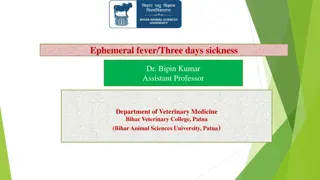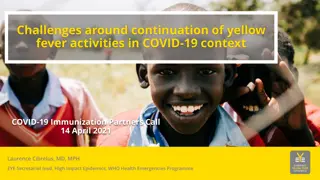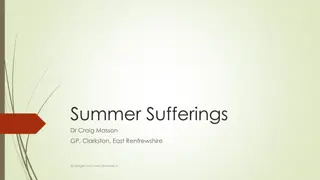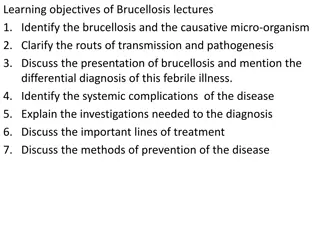Overview of Crimean-Congo Hemorrhagic Fever Virus
Crimean-Congo Hemorrhagic Fever (CCHF) virus is an RNA virus belonging to the genus Nairovirus, causing a zoonotic disease with high mortality rates in humans. The virus is transmitted mainly by ticks, particularly the Hyalomma species, and can result in severe illness in both domestic and wild animals. Recent research has shed light on the entry pathway and replication mechanisms of the virus, indicating potential targets for antiviral interventions. Understanding the transmission dynamics involving ticks and livestock is crucial in controlling the spread of CCHF.
Download Presentation

Please find below an Image/Link to download the presentation.
The content on the website is provided AS IS for your information and personal use only. It may not be sold, licensed, or shared on other websites without obtaining consent from the author.If you encounter any issues during the download, it is possible that the publisher has removed the file from their server.
You are allowed to download the files provided on this website for personal or commercial use, subject to the condition that they are used lawfully. All files are the property of their respective owners.
The content on the website is provided AS IS for your information and personal use only. It may not be sold, licensed, or shared on other websites without obtaining consent from the author.
E N D
Presentation Transcript
Crimean-Congo haemorrhagic fever (CCHF) virus is a RNA virus of geneus Nairovirus, from the Family Bunyaviridae. The disease it caused is called CCHF because it was first discovered in Crimea in 1994, so Crimean was given as part of the name; also, in 1956, the same pathogen caused a similar illness in Congo, so then the combination of the two places resulted the final term CCHF and CCHF virus. The virus is mainly seen in East and West Africa, but has also been endemic in many areas in Asia and Eastern Europe. In recent years, outbreaks have emerged from new places like Pakistan, Albania and Iran as well. CCHF is a tick-borne virus (mainly by argasid or ixodid ticks- specifically by Hyalomma, Dermacentor, Amblyomma and Rhipicephalus species). The virus causes zoonostic diseases--from both domestic and wild animals to humans. This disease can create approximately 30% of mortality in all infected individuals ( human infections are not as frequent as animals).
Alternative Disease Names Congo Fever Central Asian hemorrhagic fever Genome*Structure Circular, negative sense, ss RNA. Monomeric Segmented into 3 segments: large, medium, and small 17,100-22,800 nucleotides (complete genome) Enveloped Virion: spherical Replicates in the cytoplasm
Currently, the entry pathway and replication mechanisms for Crimean-Congo hemorrhagic fever virus (CCHFV) is still poorly understood. To provide a general understanding, the raplicaiton strategy for its genus Nairovirus is summarized below: Nairovirus enters host cells by receptor-mediated endocytosis attachment by their Gn-Gc glycoprotein dimers. The nucleic acids are released in the cytoplasm of the host cells, where replication also takes place. When virions are assembled, they exist the cells via budding. Recent advance in research has provided some insights into CCHFV: CCHFV utilizes clathrin-dependent endocytosis drugs that interfere with the formation of clathrincoated pits or the acidification of endosomes can prevent entry of virus and release of the viral genome Cholesterol depletion can limit CCHFV infection
Hyalomma tick Hyalomma tick serves as the most common vector for CCHF virus. It transmits the disease to a livestock (mainly ruminants or ostriches) through biting, then when people butcher (in contact with the blood) or eat the infected animals, they become infected as well. Illness will show after the viral incubation of three days. The transmission can be both horizontal and vertical. In the ticks the females can pass the virus to their eggs, which will develop and grow into the new adult ticks with the virus.
The virus is found around the world and can use small mammals like hare, hedgehogs and rats as reservoirs. Ticks serve as the vectors to transmit the virus to domestic animals like sheep, cows and goats and then infect humans. Although there could be high titer of virus-concentration in the animals' blood, the animals do not show any illness, so it's difficult to realize if the animals are infected.
After exposure to the virus, like by a tick bite, the virus incubates in the body first for up to three days. Then after approximately a week, the infected hosts show initial flu-like symptoms including fever, chills, severe headache, lumbar/abdominal/muscular pain, nausea, anorexia, fatigue, red eyes/throats, fatigue, vomiting, malaise and photophobia (being sensitive to light). During this time, but at least after three to five days, 75% of the cases reveal acute respiratory distress syndrome as well as the onset of hemorrhagic symptoms beginning as a petechial rash, which are skin lesions that are like broken blood vessels underneath the skin or bruises. The rash can appear both in the internal and external mucosal linings. Patients at this state can develop extreme mood swings, agitation, aggressiveness and mental confusion. At the later stage of the infection, blood can be observed in saliva, nose, stool, urine, vomit; also black stool can be seen in certain patients.
Some infected individuals can develop painful and enlarged liver (hepatomegaly), enlarged lymph node (lymphadenopathy) and swollen abdomen (abdominal organs/tissues) In severe CCHF, acute kidney failure occurs due to disseminated intravascular coagulation a type of vascular collapse that can cause death; patients have very low white blood cell count. However, this only happens in less than half of infected individuals (and only in the second week of infection). For individuals who survive after the second week of exposure, they will recover but the recovery time is very long (years). Coma, lethargy (extreme drowsiness), depression, lassitude and low blood pressure can accompany in the acute CCHF phase.
Retrieved from Centers for Disease Control, Dr. B. E. Henderson, Public Health Image Library #2136 Retrieved from Centers for Disease Control, Dr. B. E. Henderson, Public Health Image Library #2137
Observation of obvious symptoms like bleeding from various places from the body Checking for tick bites Leukopenia, Thrombocytopenia ELISA (enzyme-linked immunoassay) --can detect antibodies such as IgM and IgG levels in the suspected individuals serum but this test has to wait at least a week post- exposure in order to perform (false-negative). IgG concentration is stable and remains high for a long period of time up to five years but IgM level decreases after approximately four months but during which, there is sufficient amount that is enough for diagnosis purposes. Immunofluorescence assay (EIA) is commonly used to detect antigens from the viral particles residing in cells or infected tissues. Safely equipped laboratories should be utilized to perform any of these diagnosis tests.
Immunodeficient or malnourished individuals may not mount an adequate humoral immune response, so for these people, serological tests are not quite effective. Viral load tests should be done instead to directly observe their blood or tissues for the presence of viruses. If the viral load is low in the blood, for better observation, a few virus can be extracted and grow in enriched broth or plates with cell cultures for a few days, then use RT- PCR (CCHFV is a RNA virus) to detect viral nucleic acids.
Differential diagnosis should accompany the tests described before to help eliminate other viral diseases, which cause very similar symptoms that can interfere with the identification of CCHF virus. The viruses that can also cause hemorhagic fever or many similar illneses are: Argentinian hemorrhagic fever virus, Dengue fever virus, Ebola hemorrhagic fever virus, Lassa fever virus, Marburg fever virus, Yellow fever virus and Rift valley fever virus.
Currently, there is still no specific treatments available for CCHF Also, no effective and safe vaccine for humans There is a small portion of mouse brain-derived vaccines used in Europe (but is not recommended by many countries and is not commercially available). However, symptoms can be treated for decreasing discomfort and prolonging life Utilizing painkillers to ameliorate various pain from lesions or bleeding anti-inflammation drugs to decrease swelling of infected sites, tissues and liver antibiotics to treat secondary bacteria infections. Blood transfusion to filter out the virus under strict and careful management is recommended and usually required in later stage of acute infection. Common antiviral drug like riboflavin can be applied along with other treatments usually during outbreaks. For those who recovered, their blood now contains immunity against CCHF virus, so can be used to passively immunize other individuals, but so far this strategy is only occasionally utlized due to safety reasons.
Chemicals like acaricides can be used in livestock production industries to kill ticks and control their spread. Workers should wear protective clothes and gloves if working in endemic areas. Farmers, slaughterhouse workers and veterinarians should be cautious in handling animal blood or secretions that can be infectious. Residents who live near/in endemic areas should protect themselves by being sprayed with repellents, like DEET and permethrin (insecticide) to avoid ticks sticking to skin, clothes and/or hair. Doors, windows, and screens can be sprayed with more concentrated and harsher insecticides to prevent ticks entry into residential areas.
In the hospitals, nosocomial infections by CCHF often occur as well, so CCHF patients are usually isolated. CCHF is highly infectious and even sometimes surgeons who operate on CCHF patients can become infected. Sharps (needles), patients' blood specimens and body wastes should be decontaminated before disposal and handled carefully by healthcare workers (wearing gloves at all times and washing hands frequently before and after contacting of potential infectious materials (this virus can survive in the environment and reside on fomtes).
The virus is widespread and is capable of maintaining a very stable number in the vectors (ticks) and reservoirs for a long period of time Therefore, the vectors and animals can be used to cause outbreaks in humans in targeted areas during a biological attack. Mortality is high, so it can be used to kill large numbers Since the animals (reservoirs) do not demonstrate apparent symptoms (but reproductivity can be comprimised), the sign of an outbreak is difficult to identify, so prevention is hard to take place. Once an outbreak occurs, a huge amount of people are already infected by infected animals and ticks. It can take a long time to stop the outbreak. A favored characteristic of a biological weapon. The virus caused heath damage in people and low productivity in livestocks can lead to economic lose To fight against CCHF in a bio-attack, ticks control is crucial (acaricides). Domestic animals should be monitored and regularly tested and report any irregular behaviors or sign to the authorities. If the virus is detected, the animals should be isolated immediately from other healthy ones to minimize the spread and possible economic lose. Common disinfectants, formulated solutions, and dry heat (56 C for 30 min) and UV light can all effectively kill the virus. Areas that breed animals or process animal products should be routinely sanitized to ensure the safety and health of both animals and humans (and prevent bio-attack).























